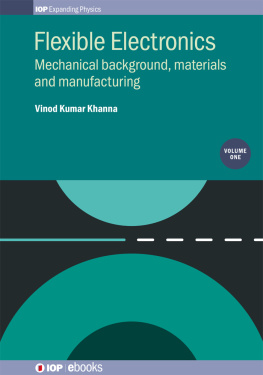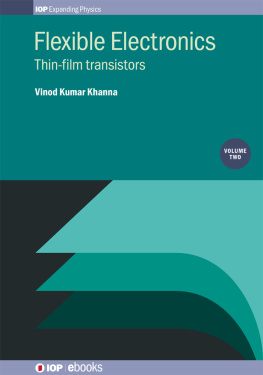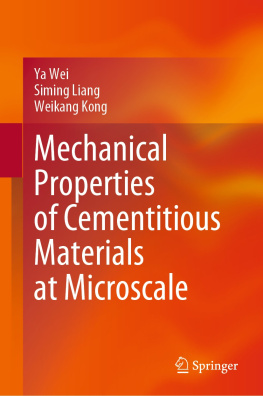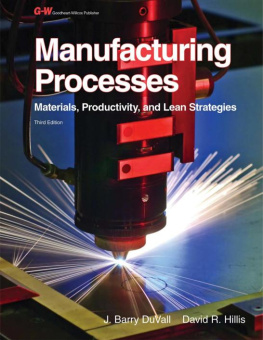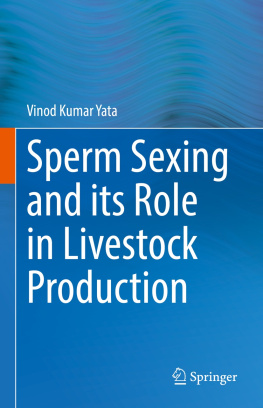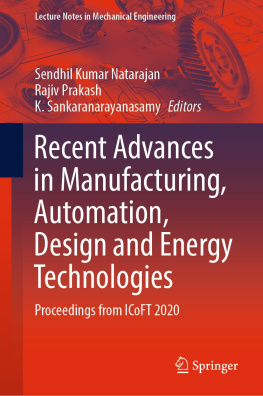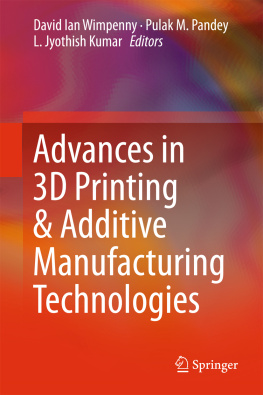Vinod Kumar Khanna - Flexible Electronics: Mechanical Background, Materials and Manufacturing
Here you can read online Vinod Kumar Khanna - Flexible Electronics: Mechanical Background, Materials and Manufacturing full text of the book (entire story) in english for free. Download pdf and epub, get meaning, cover and reviews about this ebook. year: 2019, publisher: IOP Publishing Ltd, genre: Science / Computer. Description of the work, (preface) as well as reviews are available. Best literature library LitArk.com created for fans of good reading and offers a wide selection of genres:
Romance novel
Science fiction
Adventure
Detective
Science
History
Home and family
Prose
Art
Politics
Computer
Non-fiction
Religion
Business
Children
Humor
Choose a favorite category and find really read worthwhile books. Enjoy immersion in the world of imagination, feel the emotions of the characters or learn something new for yourself, make an fascinating discovery.
- Book:Flexible Electronics: Mechanical Background, Materials and Manufacturing
- Author:
- Publisher:IOP Publishing Ltd
- Genre:
- Year:2019
- Rating:5 / 5
- Favourites:Add to favourites
- Your mark:
- 100
- 1
- 2
- 3
- 4
- 5
Flexible Electronics: Mechanical Background, Materials and Manufacturing: summary, description and annotation
We offer to read an annotation, description, summary or preface (depends on what the author of the book "Flexible Electronics: Mechanical Background, Materials and Manufacturing" wrote himself). If you haven't found the necessary information about the book — write in the comments, we will try to find it.
Flexible Electronics: Mechanical Background, Materials and Manufacturing — read online for free the complete book (whole text) full work
Below is the text of the book, divided by pages. System saving the place of the last page read, allows you to conveniently read the book "Flexible Electronics: Mechanical Background, Materials and Manufacturing" online for free, without having to search again every time where you left off. Put a bookmark, and you can go to the page where you finished reading at any time.
Font size:
Interval:
Bookmark:

Flexible Electronics, Volume 1
Mechanical background, materials and manufacturing
Vinod Kumar Khanna
CSIR-Central Electronics Engineering Research Institute (CSIR-CEERI), Pilani, India
IOP Publishing, Bristol, UK
IOP Publishing Ltd 2019
All rights reserved. No part of this publication may be reproduced, stored in a retrieval system or transmitted in any form or by any means, electronic, mechanical, photocopying, recording or otherwise, without the prior permission of the publisher, or as expressly permitted by law or under terms agreed with the appropriate rights organization. Multiple copying is permitted in accordance with the terms of licences issued by the Copyright Licensing Agency, the Copyright Clearance Centre and other reproduction rights organizations.
Permission to make use of IOP Publishing content other than as set out above may be sought at .
Vinod Kumar Khanna has asserted his right to be identified as the author of this work in accordance with sections 77 and 78 of the Copyright, Designs and Patents Act 1988.
ISBN 978-0-7503-1462-6 (ebook)
ISBN 978-0-7503-1461-9 (print)
ISBN 978-0-7503-1463-3 (mobi)
DOI 10.1088/2053-2563/ab0d16
Version: 20190701
IOP Expanding Physics
ISSN 2053-2563 (online)
ISSN 2054-7315 (print)
British Library Cataloguing-in-Publication Data: A catalogue record for this book is available from the British Library.
Published by IOP Publishing, wholly owned by The Institute of Physics, London
IOP Publishing, Temple Circus, Temple Way, Bristol, BS1 6HG, UK
US Office: IOP Publishing, Inc., 190 North Independence Mall West, Suite 601, Philadelphia, PA 19106, USA
To my late mother Smt Pushpa Khanna,
my sweetest and ever-lasting memory,
as a humble tribute of my thankfulness
for her endless love, affection and gentleness,
her sacrifices in my upbringing
and enthusiastic mentoring!
Electronics has created many wonders. Communication, computing, control, sensing/actuation and power systems have gone through dramatic changes due to advances in electronics. Automobiles, aerospace, healthcare, information, instrumentation and entertainment systems have been totally transformed over the years.
Vacuum tubes, transistors, solid-state devices, very large scale and ultra large scale integrated circuits (VLSI and ULSI), it is an unending success story of unabated progress towards smaller geometries and minimum feature sizes. Dimensions continued shrinking to the nanoscale and the miniaturization wave still continues. Then electronic scientists and engineers realized that a major portion of the silicon substrate on which the devices and circuits are built was of little use during the operation of the device except for providing mechanical support. It was an unnecessary burden and added to the weight of the electronic equipment. In particular, the equipment and photovoltaics used on space missions could be made lightweight by thinning down the processed wafer after the chip fabrication was completed. Soon, it was also realized that the redundant wafer thickness was an obstacle to the flexibility of the chip. Thinning of the wafer increased its ability to withstand bending. Thus, silicon wafers could be thinned down post-processing and the thin chips mounted on plastic substrates.
Gradually, scientists thought that they should develop capabilities for chip fabrication directly on plastic substrates. This would lead to process simplification and cost reduction. But this was a difficult decision. Plastic substrates cannot be exposed to high processing temperatures but most silicon fabrication processes require elevated temperatures. So processes were divided into two classes, namely those which could be implemented at low temperatures and those for which the high temperature route was mandatory. Lowering the temperature means compromising quality. Either the desired product will not be formed or its properties will not be up to the requisite standard. A strategy was evolved in which the high temperature steps were completed on silicon, glass or some other hard material and the low-temperature steps were done after the structure was transferred to a polymeric substrate. This paved the way towards a strategy of dividing the process into parts to be implemented on hard and soft substrates.
A scheme of momentarily exposing the organic substrates to high temperatures also received much attention, e.g. amorphous silicon could be crystallized by shining bursts of laser energy at them which would locally heat the material for a time duration short enough not to cause any harm to the underlying plastic substrate. In this way, rapid thermal annealing-based processes were also formulated.
Another line of thinking looked at organic and printed electronics. These processes are comparatively cheap. They do not require the expensive infrastructure of clean rooms. Moreover, these processes are scalable to large-area roll-to-roll manufacturing, promising high throughput. Thus, electronic circuits can be contemplated coming out of a printer in which inks for conducting, semiconducting and insulating materials are used in place of the inks of different colors for printing letters and pictures on paper. Noteworthy applications of this type include the large-area display and solar cell panels where emphasis shifts from microelectronics to macroelectronics. These applications require low-cost manufacturing using solution-processable printable polymers.
In yet another alternative, the unique properties of nanostructured materials, notably graphene, 2D transition metal dichalcogenides (TMDs), carbon nanotubes (CNTs), silicon nanowires (Si NWs) and nanoribbons are utilized to fabricate flexible chips.
With the vast spectrum of opportunities and options available, flexible electronics has made great strides. Already, a wide assortment of thin film transistors (TFTs) exist. Starting from amorphous silicon (a-Si) TFTs, we have polysilicon TFTs and single crystal silicon TFTs on the inorganic side. On the organic side, we have small molecule, polymeric and organic single crystal TFT varieties. Flexible energy devices like solar cells, batteries, supercapacitors and energy harvesters have all made great progress. The list of flexible electronic applications is very large. Displays, sensors, memories and radio frequency identification (RFID) tags are the hot topics in flexible electronics.
Flexible electronics is blossoming like a flower. It is growing and reaching diverse aspects of human life and activities. It is maturing into a very interesting discipline that is bound to touch our entire lives. Many flexible electronics products can be worn like clothing. Wearable and stretchable electronics are sister branches of flexible electronics wherein the flexing capabilities are further augmented by providing extendability and conformability features.
With all the good things that flexible electronics has brought to humankind, the field has become a completely new discipline in itself and this book is a humble attempt to bring the reader a taste of the groundbreaking research and breakthroughs in this field over the last few decades. We shall start from the very basic concepts of mechanical bending and take the reader on an entertaining journey where there are stations called materials for flexible electronics, the manufacturing processes for flexible electronic components, the thin film transistors which are the ubiquitous amplifying and switching devise in flexible electronic circuits, the sources of energy that power the flexible electronics gadgetry, and the service to mankind in the form of multifaceted manifold applications of flexible electronics. We promise that this joyride will be very captivating, informative and enjoyable. We wish that readers will find this a very useful and pleasurable experience.
Font size:
Interval:
Bookmark:
Similar books «Flexible Electronics: Mechanical Background, Materials and Manufacturing»
Look at similar books to Flexible Electronics: Mechanical Background, Materials and Manufacturing. We have selected literature similar in name and meaning in the hope of providing readers with more options to find new, interesting, not yet read works.
Discussion, reviews of the book Flexible Electronics: Mechanical Background, Materials and Manufacturing and just readers' own opinions. Leave your comments, write what you think about the work, its meaning or the main characters. Specify what exactly you liked and what you didn't like, and why you think so.

